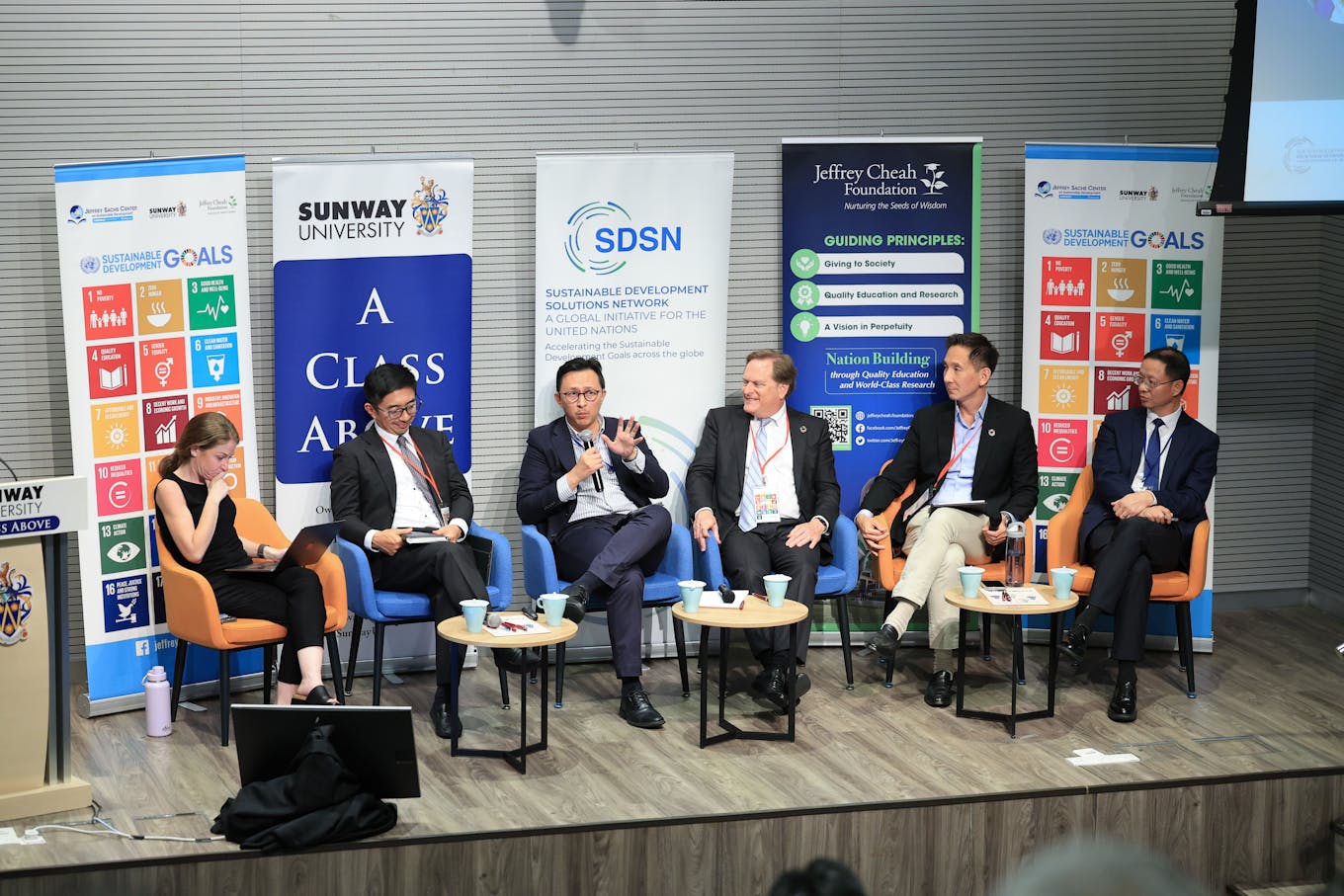Southeast Asian countries are eager to make more progress on the Asean Power Grid, which was in the spotlight this week as Malaysia, Singapore and Vietnam announced their intention to explore an undersea cable for renewable energy trade at the Asean Summit on Monday.
However, surging demand for energy-intensive data centres to support artificial intelligence (AI) growth is likely to affect electricity consumption patterns and as a result, planning for the regional grid’s interconnections.
“One of the key challenges I face in my conversations with various governments is how booming (demand for) AI-driven data centres is reshaping load forecasting,” said Jie Tang, World Bank practice manager for energy and extractive global practice in the East Asia and Pacific region.
Load forecasting refers to the process of predicting future electricity demand from a particular electricity grid and how that will change over time.
Speaking at a forum organised by the United Nations Sustainable Development Solutions Network on Sunday, Tang explained that the problem of additional electricity demand from data centres varied across markets. For instance, in a country like China, which has the largest rate of electric vehicles and has decarbonised much of its transportation sector, data centres consume less than 2 per cent of total power, he said.
“By contrast, in Lao PDR, you see a booming of data centres for bitcoin mining in Vientiane (contributing to) a load growth of 50 per cent in the first six months,” said Tang.
A year ago, an advisor to Laos’ state-run utility admitted that the country experienced power outages due to a boom in energy-intensive cryptocurrency mining, which coincided with erratic rainfall that limited hydropower output. Hydropower accounts for more than 80 per cent of electricity generated in the land-locked county.
“We need reliable and sustainable supply to meet future demand, but all that comes from planning and load forecasting,” said Tang.
Going where there is clean energy
According to a recent report by the International Energy Agency, Southeast Asia’s electricity demand from data centres more than double by 2030. Data centres accounted for around 1.5 per cent of the world’s electricity consumption in 2024, having grown at a rate of 12 per cent annually since 2017 – over four times faster than the total rate of electricity consumption.
“AI-focused data centres can draw as much electricity as power-intensive factories such as aluminium smelters, but they are much more geographically concentrated,” the report said.
This means that such data centres will have a significant impact on local energy systems, said Spencer Low, Google’s head of sustainability for the Asia Pacific region. According to Low, electricity is Google’s largest line item in terms of cost after payroll and will only grow as a cost item with the introduction of data centres that will run over the next few decades.
“Where are we going to place these assets such that they can operate safely but also effectively and efficiently from a cost perspective?” he questioned. “All the research suggests that if you take away all fossil fuel and even renewable energy subsidies, the levelised cost of energy is actually lowest for a lot of renewable energy sources.”
For this reason, technology companies like Google are interested in locating their data centres in markets where they can be assured of buying cleaner energy, knowing that this would reduce long-term operational costs, said Low.
“I won’t speak for all data centres, but for many hyperscalers including Google, there is a commitment to building data centres and developing AI by incorporating ever-increasing amounts of carbon-free energy,” he said.
“We would be less attracted to destinations that did not offer us at least a pathway to, ideally, 100 per cent carbon-free energy by a certain time.”

On a panel discussion, Jie Tang (far right), practice manager for energy and extractive global practice in the East Asia and Pacific Region at The World Bank, pointed out how data centres for artificial intelligence was changing electricity load forecasting. Image: United Nations Sustainable Development Solutions Network
Can tech giants make clean energy bankable?
Asean’s data centres are currently concentrated in Singapore and Malaysia’s neighbouring state of Johor. Technology companies including United States-headquartered Equinix and Australia-based AirTrunk have made plans to scale up their data centre operations in the region, where the biggest data centres are currently concentrated in Singapore and Malaysia’s neighbouring state of Johor.
On Monday, both countries signed an agreement with Vietnam to explore the potential of using undersea cables and Malaysia’s national electricity grid to transfer renewable energy from Vietnam to its southern neighbours.
Malaysian prime minister Anwar Ibrahim said that this would be the first phase of the APG’s planned expansion as it is considered among the more economically viable of interconnectors, with future efforts to focus on connecting more countries in the region.
But the feasibility of increasing interconnectors is also subject to external market forces. Dr Keiju Mitsuhashi, director of the energy sector office at Asian Development Bank (ADB) pointed out that global demand for undersea cables has been high due to its use in offshore wind projects.
“[Asean countries] may have to wait several years before they can start procuring these cables – that’s the lead time they require,” he said. “How do you get finance for that when there’s that uncertainty?”
Google’s Low acknowledged that because of the growing demand by tech giants for secure and reliable clean energy, many are prioritising the concept of additionality, which means that they would be adding new renewable energy to the grid instead of drawing from existing sources.
This gives such companies, which typically have high credit ratings, a unique opportunity to support the financial viability of clean energy projects, he said. “If we sign a 10 or 20-year power purchase agreement, that tends to help make projects more bankable.”
Derisking finance still needed
Multilateral development banks are committing financial support to the regional grid’s development, too. On Monday, it was revealed that ADB and the World Bank will be launching a Finance Facility Framework for the APG this October, to coincide with an anticipated regional agreement for an enhanced APG, according to Malaysia’s minister for investment, trade and industry Tengku Zafrul Aziz.
In discussing the Finance Facility Framework, Satvinder Singh, Asean deputy secretary-general for the region’s economic community, said that the banks would offer capacity building support, grants, feasibility studies and financing facilities.
But these banks’ support for the APG is not new. ADB’s Mitsuhashi said that the bank has studied ASEAN’s potential for grid harmonisation and interconnectors for over 20 years, even financing some of these projects.
For example, there is already an interconnection from Laos to Thailand and ADB has been financing Laos’ first wind farm, the 600-megawatt Monsoon project, since 2023, which will also supply clean energy to neighbouring Vietnam.
However, more long-term studies are needed to assess the feasibility of future individual projects, which would take years, Mitsuhashi said.
He also pointed out that these projects, themselves do not generate revenue, which is why derisking finance through mechanisms like blended finance is critical. This could involve a combination of sovereign funds, private sector financing and support from multilateral banks such as ADB, the World Bank and the Asian Infrastructure Investment Bank to offer technical assistance and grants for feasibility studies.
“
“We [hyperscalers] would be less attracted to destinations that did not offer us at least a pathway to, ideally, 100 per cent carbon-free energy by a certain time.”
Spencer Low, head of sustainability, Google APAC
Asean Centre of Energy seeks mandate
According to Tang, the World Bank recently approved a US$12.7 million grant to the Asean Centre for Energy (ACE) to work on identifying what the critical next projects are in terms of planning for the APG. The Centre is an intergovernmental organisation within the Asean structure that represents the energy interests of all 10 member states.
Speaking at the same Sunday event, ACE executive director Abdul Razib Dawood said that under Malaysia’s chairmanship of Asean this year, the centre has been “tasked to achieve a breakthrough on the APG.”
“ACE is well equipped, as a think tank…to (use our) capabilities, competencies and tools to run optimisation analyses (for the decarbonisation and integration of the regional power grid),” he said. “What we are looking forward to is the mandate of the Asean leaders (to do this work).”
American economist Jeffrey Sachs, who was formerly director of The Earth Institute at Columbia University said that the centre’s work will be critical in informing policymakers of critical, climate-responsive decarbonisation pathways for the energy sector
“It’s not only waiting for the mandate – you need to run all the scenarios so (politicians) understand what the alternatives are,” he said, citing scenarios such as Asean striving for full decarbonisation, whether with or without nuclear, or with or without a more integrated APG.
Stressing the urgency of the climate crisis and the projected impact of rising global temperatures, Sachs urged Asean’s political leaders to act immediately.
“Your fate as political leaders (is that) you are responsible for your countries. You need to have the best possible information to make choices that are responsible for your people.”










